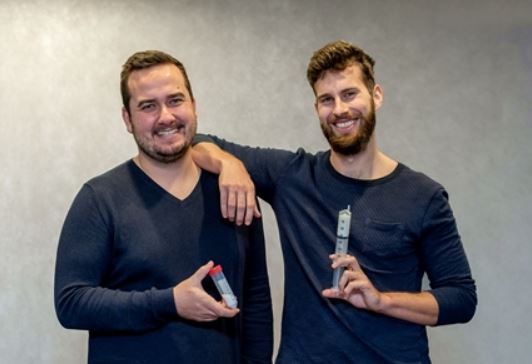Award-winning innovations
When innovative projects and achievements in technology transfer stand out, they should be recognized accordingly. Among the innovations bridging the gap between science and industry in 2020 and beyond are three developments that have now received the "Empa Innovation Award": a nanoparticle adhesive for wounds, a transparent corona mask and software for sustainable energy use.

The first prize of this year's "Empa Innovation Award" (see box) goes to a healthcare technology that is retiring surgical sutures: Nanoglue is a novel tissue adhesive technology that promises faster and safer wound healing. It was developed by researchers at Empa's Particles-Biology Interactions Laboratory in St. Gallen in collaboration with ETH's Nanoparticle Systems Engineering Lab. Their approach differs radically from existing solutions because it uses the wound-healing properties of inorganic hybrid materials.
Unlike previous wound adhesives, which mainly consist of the body's own protein fibrin, the technology is based on a combination of inorganic nanoparticles. Depending on the formulation, the adhesive particles bind particularly well to bone or soft tissue. Further wound-healing effects, such as accelerated blood clotting, are promising for the treatment of external and internal wounds.
The wound adhesive (see video here)is based on low-cost materials that can be manufactured on a large scale and adheres strongly to tissue, as experiments with prototypes have shown. Nanoglue can thus ensure faster and safer wound healing, benefiting patients, hospitals and the economy. Until now, poorly healing wounds have been a major burden for those affected and an increasing cost factor for the healthcare system.
Empa researcher and ETH Pioneer Fellow Tino Matter, together with Sebastian Loy (HSG), is trying to bring the unique technology to market with their spin-off company anavo (not yet founded). anavo has already made it to the finals of the Swiss Innovation Forum and Venture Kick, Switzerland's largest start-up funding programme. It has also secured further funding from Startfeld and Innosuisse. "Intensive research has been going on in nanotechnology for decades. Now the time is ripe to bring a nanomedical innovation to market," says Matter.
Hello Mask Project
The Hello Mask project (see video here), in which researchers from Empa and EPFL developed a transparent face mask. The Hello Mask is a prime example of an innovation that can solve tomorrow's problems: Back in 2018, the ambitious team started with the goal of producing transparent surgical masks that keep germs out but do not obscure the wearer's lip movement and facial expressions. While face masks are now used by the millions in everyday life due to the Corona pandemic, at the same time the need for transparent masks was growing in various population groups such as healthcare or school personnel. Associations for the deaf and nursing homes are also very interested in such a mask.
At the same time, the start-up company "HMCare", founded in 2020 by Empa and EPFL, is working diligently on the market launch of the Hello Mask. The transparent surgical mask should now be available by mid-2021. "The fully transparent mask was developed primarily with the aim of improving the relationship between nurses and patients," said Empa researcher Joshua Avossa from the "Biomimetic Membranes and Textiles" department in St. Gallen, who accepted the award. Two years of joint research at Empa and EPFL were required to reconcile transparency, durability and porosity in particular. The result is a membrane made of a polymer developed specifically for this application. "We can produce such fine membranes with a pore size of about 100 nanometres using what is known as electrospinning," says the researcher. The arrangement of the fibers creates tiny gaps that allow air to pass through, but retain viruses and bacteria.
Sustainable energy systems
The winners of the "Empa Innovation Award" also include "Urban Sympheny", a software platform for planning sustainable energy systems (see video here). Founded in 2020, the Empa spin-off focuses on software-based support for the planning of sustainable energy systems for urban districts, counties and communities. The goal is to help energy system planners quickly, comprehensively and effectively navigate the spectrum of available technology options in energy system planning and identify a set of optimal design solutions tailored to the specific constraints and goals of a given site and client. "We offer a flexible SaaS (Software as a Service) platform that enhances existing workflows at our clients' sites, reducing project costs and enabling designers to achieve ambitious goals in energy efficiency strategies," said Sympheny CEO Andrew Bollinger. The innovative software platform was developed in Empa's Urban Energy Systems department as part of the Swiss Competence Center for Energy Research (SCCER) Future Energy Efficient Buildings & Districts. Last year, Urban Sympheny was already awarded by Venture Kick and received CHF 50,000.
The Empa Innovation Award
Every two years since 2006 Empa has presented the "Empa Innovation Award" for outstanding innovation and technology transfer projects. The prize, worth CHF 5,000, honors an individual, a group or a department for excellent innovations or a successful technology transfer to the private sector. In addition, two recognition prizes of CHF 2,000 each will be awarded. In this way Empa is rewarding the efforts of its researchers to further build bridges between science and industry through applied, market-oriented research. Today, spin-offs or industrial partners market the innovation and technology transfer projects of the previous winners.









